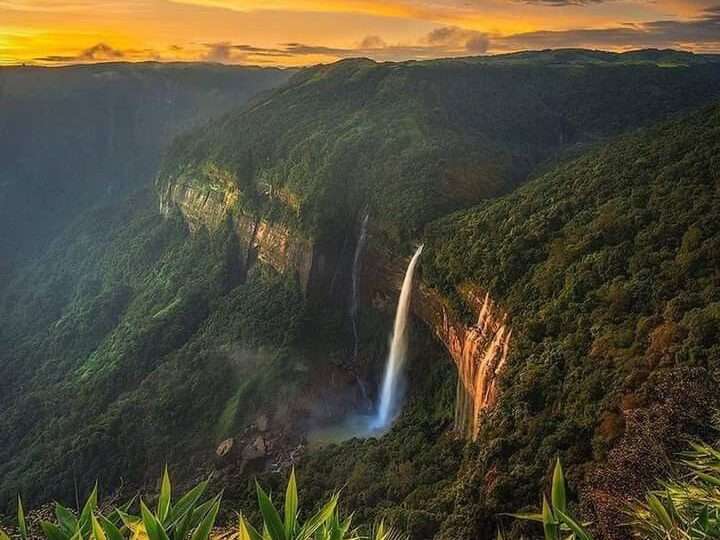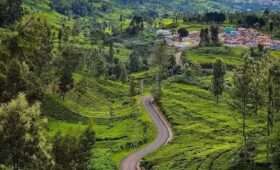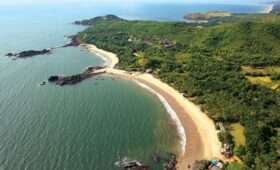Meghalaya has a lot of gorgeous natural scenery. Your awe and admiration for Meghalaya’s amazing appeal will follow you wherever you go. From serene waterfalls to verdant forests, deep prehistoric caverns, and magnificent good culture and traditions. I appreciate the kindness and good-natured individuals very much.
Meghalaya comes to mind first when we consider a region that is completely covered with natural beauty. Because of its mountains, valleys, rivers, lakes, and waterfalls, Meghalaya, which translates literally as “Abode of Clouds,” has one of the most picturesque landscapes on earth. Those are the waterfalls in Meghalaya that exude beauty and tranquilly, and you should find them.
Mid-June through September is the monsoon months. Numerous waterfalls emerge from the mountains and cascade down raging canyons. During this time of year, the hills are covered under a blanket of clouds, and the entire area is surrounded by meadows with lush, deep green grass. For every traveller, this is eye pleasing.
Landscapes painted in autumnal tones are available during the dry season, which lasts from November to June. While some waterfalls dry up, the clear, sunny weather of this time of year enables us to explore certain places that would otherwise be shrouded in mist and fog during the monsoon. Therefore, it is preferable to visit Meghalaya in both seasons.
- Elephant waterfalls
Three-tiered stunning cascade known as Elephant Falls. This waterfall, which is near Shillong Peak, is known locally as “Ka Kshaid Lai Pateng Khohsiew,” or “three-step waterfalls.” After the monsoon season, especially from October to December, it is stunning and torrential and is located in Shillong’s thick and lush forests. Its elephant-like gigantic boulder that lies at the base of the waterfall inspired the name. The rock was demolished by an earthquake, thus it isn’t there right now. This location, which is 12 km outside of Shillong, is frequently visited by both tourists and residents, especially on the weekends.
- Seven Sisters Falls
Seven Sisters Falls, one of Meghalaya’s most beautiful waterfalls, is a seven-step cascade that cascades down from a height of 1033 feet over the limestone cliffs of the Khasi Hills, making it one of the highest waterfalls in India. When the brooks are flowing at their fullest, between July and September is the finest time to view this cascade. The waterfall’s magnificence as it divides into seven streams while being encircled by lovely, lush trees will leave you in awe.
- Kynrem Falls
This waterfall, one of the highest in Meghalaya, is close to Cherrapunji. Kynrem Falls, which is roughly 1003 feet in height, is ranked as India’s seventh-highest waterfall. It displays its mesmerising splendour throughout the post-monsoon and winter months. Pillar Rock, also known as Shiva Rock, is one of the main draws in this area. The enormous rock, sometimes referred to as Khoh Ramhah or Mothorp, is situated right next to the falls and provides a breathtaking perspective of the Meghalayan lowlands.
- Nohkalikai Falls
There is 7 kilometres distance between Cherrapunji and Nohkalikai Falls. It is well known for being India’s tallest waterfall with a plunge. A deep plunge pool is created by the water as it tumbles from a great height, creating an amazing sight. On top of the falls, there is a viewing gallery that one can ascend to get a birds-eye perspective of the cascade and plunge pool.
- Bishop and Beadon Falls
Brothers from Meghalaya named Bishop and Beadon. A watercourse that drops three stories from a height of 446 feet is called Bishop Falls. The water drops in the can are showered in mist and mist, and the bishop’s foamy water gushes out, revealing the surrounding landscape and rocky hills. delve in deeply. Both waterfalls flow through the beautiful Suna Valley before plunging into the Umiam River’s steep gorge.
- Mawphlang Falls
Mawphlang is one of the most stunning waterfalls in the state. It is a serene fall in the Mawhplang Sacred Forests that cascades down numerous stages from a sizable height. A little plunge pool surrounded by waterfalls is the perfect place to unwind, rejuvenate, and spend some time in the tranquilly nature. Take a swim and dip your feet into the plunge pool to unwind. Locals in Mawhplang Sacred Forest hold a special reverence for the trees. Going through this woodland and taking part in such worship is also an unforgettable experience.
- Dainthlen Waterfalls
One of the waterfalls in Sohra, adjacent to Cherrapunji, that is most frequently photographed is Dainthlen Falls, which is well known for its breathtaking scenery. In keeping with local legend, a large serpent that used to reside in a nearby cave called the waterfall into being. Due to the harm, it was causing to the community, the natives killed this large snake. The calmest and most majestic sight that can be experienced is the sight of the water rushing down in all its pressure.
- Langshiang Falls
The Langshiang Falls is created by the river Kynshi as it flows through the West Khasi Hills. It is one of Meghalaya’s largest cascades and is situated close to Nongstoin, amidst Sangriang’s forests. This waterfall, which the locals refer to as “kshaid Ur-Nar,” is refreshingly beautiful and gives views of the nearby hamlets and lush hills.
- Bophill Falls
Bophill Falls in Meghalaya is an unloved yet breathtaking waterfall that is located close to Dwaki at the border between India and Bangladesh. When it rains and after the monsoon, this rushing stream displays its beauty and charm. Bophill Falls, a favourite of photographers and nature lovers, offers a panoramic view of Bangladesh’s lowlands on the other side and the Khasi Hills on the other.
- Krang Suri Falls
The Krang Suri Falls are another waterfall that is among the most beautiful and magical. Because of its breathtaking views, many individuals find this natural wonder to be stimulating. This waterfall, which is situated in the Amlaren Civil Sub Division, is embellished with paths built of chiselled and gravelling stones, large overlooks from which one may take in the amazing grandeur, and abundant vegetation that has thousands of different shades of green. The workers chose the stones for these walkways’ construction, which came in a variety of colours. Because they were not maintained with concrete, they are symmetrically positioned, allowing one to see the true colours.



